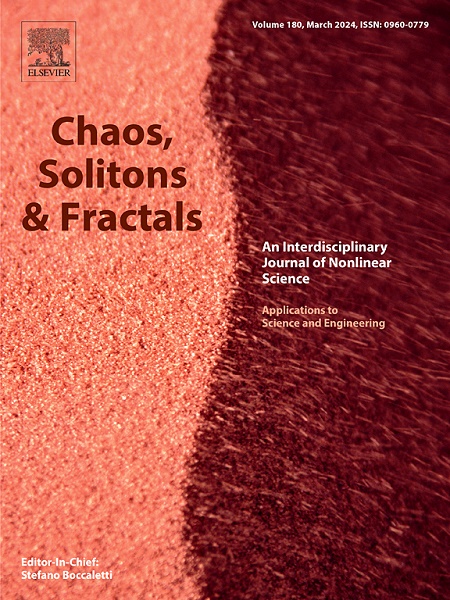Dynamic analysis of the nonlinear fiber oscillator with fractional-order control in multi-filament fiber winding
IF 5.6
1区 数学
Q1 MATHEMATICS, INTERDISCIPLINARY APPLICATIONS
引用次数: 0
Abstract
This work aims to investigate the dynamic behavior of the carbon fiber oscillator in the winding process of the novel multi-filament fiber winding equipment for high-pressure vessels, employing an improved fractional-order controller. Specifically, a coupling suppression fractional-order PD (CS-FOPD) control strategy is proposed for the two-degree-of-freedom carbon fiber oscillator. The multiple-scales method is employed to analyze the primary resonance of the system and derive the steady-state amplitude and phase solutions. The stability of the system is assessed using the Routh-Hurwitz criterion, and the analytical solutions are validated through numerical simulations. Furthermore, numerical simulations are conducted to investigate the effects of CS-FOPD control on the amplitude-frequency characteristics, controller performance, multi-stable phenomenon, attraction domain structure, and global bifurcation behavior of the system under varying system parameters. In the absence of coupling suppression strategy, the primary-superharmonic resonance characteristics are analyzed using the multiple-scales method, and stability is evaluated via Lyapunov's first method. The nonlinear dynamics of the system are further explored through amplitude-frequency response curves and attraction domain evolution. Finally, the Melnikov method is employed to calculate the distance between stable and unstable manifolds, providing an analytical prediction of the onset of chaos. The main obtained simulation results showed the excellent performance of the proposed control strategy and the evolution of the system's dynamic characteristics. By analyzing the nonlinear dynamics of the system under the proposed control strategy, this study provides key insights for optimizing the stability and performance of the novel multi-filament carbon fiber winding equipment.
多丝光纤缠绕中分数阶控制非线性光纤振荡器的动力学分析
采用改进的分数阶控制器,研究了高压容器用新型多丝纤维缠绕设备缠绕过程中碳纤维振荡器的动态行为。针对二自由度碳纤维振荡器,提出了一种耦合抑制分数阶PD (CS-FOPD)控制策略。采用多尺度法对系统的主共振进行了分析,得到了系统的稳态幅值和相位解。利用Routh-Hurwitz准则评估了系统的稳定性,并通过数值模拟验证了解析解的正确性。通过数值仿真研究了CS-FOPD控制在不同系统参数下对系统幅频特性、控制器性能、多稳定现象、吸引域结构和全局分岔行为的影响。在没有耦合抑制策略的情况下,采用多尺度法分析了系统的一次-超谐波谐振特性,并采用Lyapunov第一方法评估了系统的稳定性。通过幅频响应曲线和吸引域演化进一步探讨了系统的非线性动力学特性。最后,利用Melnikov方法计算稳定流形与不稳定流形之间的距离,给出混沌发生的解析性预测。仿真结果表明了所提控制策略的优良性能和系统动态特性的演化。通过分析所提出的控制策略下系统的非线性动力学,本研究为优化新型多丝碳纤维缠绕设备的稳定性和性能提供了关键见解。
本文章由计算机程序翻译,如有差异,请以英文原文为准。
求助全文
约1分钟内获得全文
求助全文
来源期刊

Chaos Solitons & Fractals
物理-数学跨学科应用
CiteScore
13.20
自引率
10.30%
发文量
1087
审稿时长
9 months
期刊介绍:
Chaos, Solitons & Fractals strives to establish itself as a premier journal in the interdisciplinary realm of Nonlinear Science, Non-equilibrium, and Complex Phenomena. It welcomes submissions covering a broad spectrum of topics within this field, including dynamics, non-equilibrium processes in physics, chemistry, and geophysics, complex matter and networks, mathematical models, computational biology, applications to quantum and mesoscopic phenomena, fluctuations and random processes, self-organization, and social phenomena.
 求助内容:
求助内容: 应助结果提醒方式:
应助结果提醒方式:


